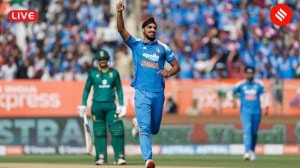Stay updated with the latest - Click here to follow us on Instagram
Gateway Litfest Day 2: Panel discusses literature in ‘script-free languages’
The panel, chaired by Khasi author Desmond Kharmawaphlang, also included Chandana Dutt (Maithili), Damodar Mauzo (Konkani), Ramesh Suryawanshi (Ahirani) and Padma Shri recipient Haldhar Nag (Kosli).
 (From left) Ambar Sahil Chatterjee, Anup Jerajani, Mini Krishnan and Aditi Maheswari during the panel discussion
(From left) Ambar Sahil Chatterjee, Anup Jerajani, Mini Krishnan and Aditi Maheswari during the panel discussion
The language in which we create, also creates us. This proverb, originally in Hindi, read out by Bhojpuri writer Parichay Das at the third edition of Gateway LitFest, aptly summed up the need for the session he was speaking at. He was a part of the panel on ‘Script-free Languages: Persisting Challenges for Languages that use Scripts of Other Languages’, on Day 2 of the annual literary festival that aims to focus on Indian literature in regional languages. Explaining the thought, he added, “We don’t just use a language to create; it also safeguards and protects our emotions and memories that we may not be able to express as succinctly in other languages.”
The panel, chaired by Khasi author Desmond Kharmawaphlang, also included Chandana Dutt (Maithili), Damodar Mauzo (Konkani), Ramesh Suryawanshi (Ahirani) and Padma Shri recipient Haldhar Nag (Kosli).
Watch What Else Is making News
The discussion chiefly revolved around folklore and history behind the lack of scripts for these languages and how each has adopted scripts of other languages to survive.
Kharmawaphlang recounted the folk tale according to which Khasi did have a script, which was lost when its bearer ended up swallowing the script while trying to safely transport it. “He had been honoured with the script by the goddess but the heavy downpour in Cherrapunji, where Khasis are from, caused a near-flood. In an attempt to save the script, the bearer clenched it between his teeth and attempted to swim across the river, but ended up swallowing it,” said Kharmawaphlang.
Dutt spoke at length about the wide use of Maithili, four crore people, and how the ancient language gave birth to Bangla, Odiya and Nepali. The original script for Maithili, Tirhuta, isn’t lost but has fallen out of use, overtaken by Devanagri. “It’s beautiful, but often confused with the Bangla script,” he explained, adding that Maithili is believed to be the language of Mithila, the land that is the birthplace of Sita. “In our language, we also abuse Ram out of love, because he is our son-in-law.”
The other author to evoke the Ramayana to elaborate on the origins of his language was Nag. Kosli, he explained, is the language of Kaushalya, Ram’s mother. Used by as many as 2.5 crore people, it got sidelined after the separation of Odisha. Nag is currently working towards having the language brought under Kendriya Sahitya in order to protect it from extinction.
The wide usage of a language, sadly, does not imply that the literature of the language is as widely circulated. A case in point here would be Bhojpuri. As Das pointed out, the original Kaithi script might have been replaced by Devanagri, bringing it a wider audience, but Bhojpuri continues to be treated as a folk script. “The leaders of seven nations outside of India, including Mauritius, Trinidad and Nepal — are Bhojpuri. But that has done little to bring this language the attention it deserves,” Das rued.
While Bhojpuri enjoys a popular presence across India through migrants, Ahirani, the language spoken by people in Khandesh, Maharashtra, remains relatively unknown. As Suryawanshi pointed out, it’s incorrect to believe that everyone in Maharashtra speaks Marathi.
However, Marathi has had a strong impact on Mazuo’s mother tongue, Konkani. As part of the panel, Mazuo pointed out that in contrast to the other languages being discussed, Konkani perhaps suffers from the problem of plenty when it comes to scripts. “It’s written in Kannada, Perso-Arabic, Malayalam, Roman and, historically, in Devanagri,” he explained. The use of Devanagri, he said, was diluted because of various historical factors, including migration to Karnataka and Kerala, the invasion of the Portuguese, and the ban on speaking and writing of Konkani by the Franciscan missionaries in 1684. “But we are slowly moving back towards Devanagri as we believe that is important for the development of a language,” he added.
While these languages may have adopted scripts of other languages but they have no doubt about also being benefitted from that.
As Mazuo said, “Through access to the language from which we borrow the script, for instance Marathi for Konkani, it inspires us to create literature that is on par with the best from that language.”







